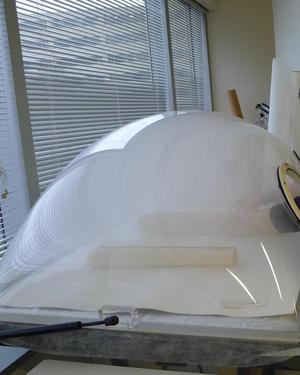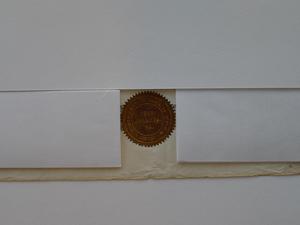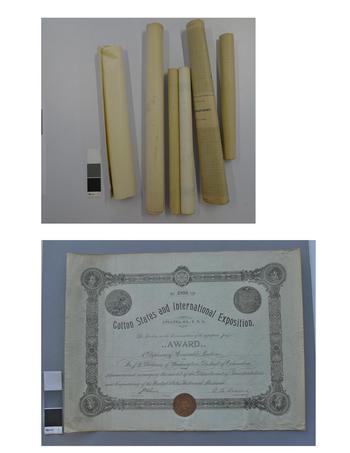 With the dry cold weather upon us, I thought it would be therapeutic to share with you some treatments from the lab showing a day at the spa, at least for our paper documents!
With the dry cold weather upon us, I thought it would be therapeutic to share with you some treatments from the lab showing a day at the spa, at least for our paper documents!

Recently, the conservation lab acquired some tightly rolled documents in dire need of flattening. Since it was hard to view them in their current rolled state, and we prefer to reduce risk by storing items flat when we can, we decided it was best to try and unroll them. Unfortunately, they were also quite brittle, so simply unrolling them by hand would have possibly induced damaging wrinkles and cracks. With these factors in mind, I chose to prepare them for a moisture rich “retreat”, otherwise known as humidification, to help open them up. This process involves carefully reintroducing moisture into the paper to relax the fibers, allowing the rolled paper to slowly open and expand, followed by controlled drying between absorbent blotter, felts, and weights. The result is a much happier, flatter and generally more flexible paper. You might remember this process nicely detailed in a past post, Halloween Humidification Horrors.

To prepare, I gently scrolled through the papers to examine for dust and dirt, and to look for any trouble spots such as adhesives, seals, or inks that might bleed or change under high humidity. As I did, I gently cleaned the documents’ surfaces with a soft cotton swab to remove as much dirt as possible, an important step as dirt can sink further into the paper during humidification making it much harder to remove afterwards. Once ready, I placed the rolled documents inside the closed humidity chamber, where the paper fibers could begin their “spa treatment”. The only thing missing was some ambient music! The chamber, as seen in the enclosed bubble above, reached a comfortable 80% relative humidity as observed on our humidity indicator card. Perfect for the fibers to become stress free and let go.

Generally, paper is naturally hygroscopic, meaning it readily absorbs and holds water vapor. However, depending on how it was made and the histories the individual documents have of use and storage, the moisture uptake of dissimilar papers will vary. While some may take a short time to relax, others may take longer, so I frequently checked and tested during their time in the chamber to see which of the documents had already begun to uncurl and could be opened even further. Once the documents did not resist opening and had lost all their prior stiffness, I carefully placed them in a sandwich of blotter papers and felts, selecting the surfaces of blotter to match the paper surface characteristics, while protecting raised embedded elements such as seals by building up a protective barrier. Lastly, I placed restraints and weight to flatten and let the drying happen in a controlled manner. Several days later, the documents were somewhat rejuvenated, being sufficiently dry and flat, as you can see in the before and after photographs below! I hope all of you get some much needed spa treatment soon to get through this dry cold winter as well!”

Related Resources
- How to Flatten Rolled Documents, National Park Service
- Halloween Humidification Horrors, The Bigger Picture blog, Smithsonian Institution Archives
- The Quest for Walcott's Quarry, The Bigger Picture blog, Smithsonian Institution Archives
Produced by the Smithsonian Institution Archives. For copyright questions, please see the Terms of Use.

Leave a Comment